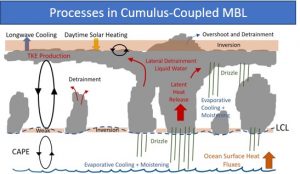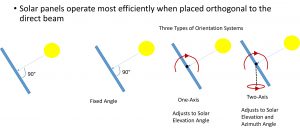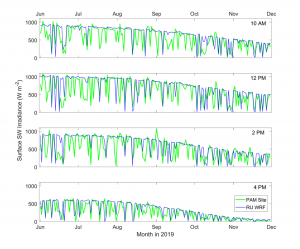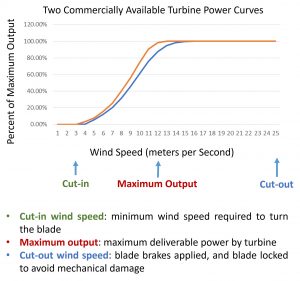Research
The role of clouds in our society is incalculable. The precipitation that they produce is the lifeblood of our continents and without help from clouds life may never have migrated from the sea. It is even possible that life itself was born in the clouds. Temperatures on our planet continue to warm due to the accumulation of Carbon Dioxide and other anthropogenic greenhouse gases in our atmosphere that are bioproducts of the combustion of fossil fuels. Observations and climate models show that as our atmosphere is warming it is becoming more moist, but there is no clear understanding of the evolution of the Earth’s cloud systems as our atmosphere warms and moistens. Do some regions have more clouds in the future while other regions have less? This question motivates much of our research.
Accompanying a warming climate induced by human activity is a necessary move toward planetary net-zero greenhouse gas emissions. Failure to reach this goal within the next decade or two will ensure undesired and significant changes in the physical and socioeconomic structure of our planet. Achieving this goal will require conservation, reducing the use of fossil fuels, and increasing the use of alternative energy. Solar and wind power involve radiation transfer and boundary layer physics, which form the foundation of our research, so we apply our expertise to increase the use and efficiency of solar panel arrays and wind generation systems.
-
We are currently living in what I refer to as the “cloud age”, which began approximately 50-years ago. While this atmospheric cloud age is not the same as the “cloud computing age”, they are complementary. Advances in computer processing power have enabled advanced simulations of clouds in parallel with a revolution in remote sensing technology that can be used to measure the fine internal details of clouds and the environment in which they exist. These new tools have created a heretofore unseen synergy between theory, models, and observation that has lead to a rapid increase in our understanding. The cloud age has produced new measurements that have often confounded what we thought we knew about clouds unmasking new aspects of their life cycle and generating new questions about their function. We remain transfixed on the plethora of cloud-related scientific questions with an ever-increasing urgency, pressed onward by a climate that we are changing and the better understanding of clouds that we require. The cloud age continues.
-
Marine boundary layer (MBL) stratocumulus cloud systems cover a substantial portion of the world’s oceans and are a major modulator of the planetary radiation budget, particularly in the mid- and high latitudes (Wood, 2012, Bennartz et al., 2013; Bodas‐Salcedo et al., 2016). Simulating these cloud systems in Global Climate Models (GCMs) is challenging and the fate of these systems is a major source of uncertainty in predicting future climate states (Boucher et al., 2013).
Part of the challenge is caused by the fact that the key morphological components of stratocumulus cloud systems evolve as they transition from a layer of stratocumulus to cumulus-coupled stratocumulus, and ultimately to cumulus; a transition, which leads to gradients in the over-ocean cloud fraction and cloud albedo that impact the global radiation budget. Stratocumulus transitions occur i) latitudinally due to increasing sea-surface temperatures and reduced subsidence toward the tropics, ii) across sharp ocean upwelling gradients along the eastern margins of the ocean basins, iii) in post-cold frontal environments in the mid- and high latitudes, and iv) spontaneously possibly in relation to cloud-aerosol interactions. Recent modeling studies have suggested that planet-wide transitions from stratocumulus to cumulus are not out of the realm of possibilities if the concentration of carbon dioxide and other greenhouse gases substantially increases and that solar geoengineering may be ineffective in preventing the runaway warming of such a transition (Schneider et al., 2019; Schneider et al., 2020). Precipitation, especially drizzle, is ubiquitous in marine stratocumulus cloud systems and is critical to their morphology.
Our group conducts basic research to help understand the physics of marine stratocumulus and how these physics can be represented in models.
We are particularly interested in the mechanisms that lead to particular patterns of cloud morphology in marine stratocumulus cloud systems. Transitioning marine stratocumulus cloud systems have been observed by satellite platforms include mesoscale patterns that can be generally grouped into four categories: no mesoscale cellular convection (MCC), closed-cell MCC, open-cell MCC, and cellular but disorganized (Wood and Hartman, 2006). Observations of such systems collected from the ground also revealed that stratocumulus transition regions frequently exhibit organized clusters of cumulus convection that appear to feed an anvil-like stratocumulus deck above a structure. We will refer to these cumuli “coupled” stratocumulus as marine boundary layer convective complexes (MBLCC; Albrecht et al., 1995; Miller and Albrecht, 1995). One goal of our current research is to document the climatology and morphology of MBLCC’s over the Eastern North Atlantic (ENA) and beyond.
A critical process in the MBL is sub-cloud layer decoupling, which is a process whereby the MBL may be thermodynamically separated into two or more sublayers. Decoupling in a stratocumulus-topped MBL is a necessary, but not sufficient, condition to enable the formation of cumulus clouds and is known to be a crucial determinant of MBL cloud morphology in the stratocumulus cloud system (Bretherton and Wyant, 1997; Kazemirad and Miller, 2020). When cumulus clouds form beneath an existing later of stratocumulus at the top of the MBL, the cloud morphology is often referred to as “cumulus-coupled”.

Thermodynamic decoupling involves the development of a weak thermal inversion in the sub-cloud layer that resists vertical transports of scalars by turbulence. Dynamic decoupling, which may also reorganize vertical turbulent transports, can result from mechanical forcing due to wind shear. While dynamic decoupling is generally thought to be less important than thermodynamic decoupling in the marine stratocumulus system, it may be episodically important in the vicinity of shallow marine frontal zones, which are often observed in mid-latitude ocean regions. Many of the physical processes operating in the cumulus-coupled MBL are indicated in the figure to the left.
We pursue a broad research agenda to better understand the innerworkings of marine stratocumulus cloud systems. Tools that we use in this pursuit include advanced surface-based remote sensors and high resolution weather forecast models.
References
Albrecht, B. A., Bretherton, C. S., Johnson, D., Scubert, W. H., & Frisch, A. S., 1995: The Atlantic Stratocumulus Transition Experiment—ASTEX, Bull. Amer. Met. Soc., 76, 889-904.
Bennartz, R., M. Shupe , D. Turner , V. Walden , K. Steffen , C. Cox , M. S. Kulie , N. Miller , C. Pettersen, 2013: July 2012 Greenland melt extent enhanced by low-level liquid clouds. Nature, 496, 83-86.
Bodas‐Salcedo, A., Hill, P. G., Furtado, K., Williams, K. D., Field, P. R., Manners, J. C., and Hyder, P., 2016: Large contribution of supercooled liquid clouds to the solar radiation budget of the Southern Ocean, J. Clim., 29, 4213-4228.
Boucher, O., D. Randall, P. Artaxo, C. Bretherton, G. Feingold, P. Forster, V.-M. Kerminen, Y. Kondo, H. Liao, U. Lohmann, P. Rasch, S.K. Satheesh, S. Sherwood, B. Stevens, and X.Y. Zhang, 2013: Clouds and aerosols. In Climate Change 2013: The Physical Science Basis. Contribution of Working Group I to the Fifth Assessment Report of the Intergovernmental Panel on Climate Change. T.F. Stocker, D. Qin, G.-K. Plattner, M. Tignor, S.K. Allen, J. Doschung, A. Nauels, Y. Xia, V. Bex, and P.M. Midgley, Eds. Cambridge University Press, pp. 571-657.
Bretherton, C. S., and M. C. Wyant, 1997: Moisture Transport, Lower-Tropospheric Stability, and Decoupling of Cloud-Topped Boundary Layers. J. Atmos. Sci., 54, 148–167.
Kazemirad, M., and M. A. Miller, 2020: Summertime Post-Cold-Frontal Marine Stratocumulus Transition Processes over the Eastern North Atlantic. J. Atmos. Sci., 77, 2011-2037.
Miller, M.A. and B.A. Albrecht, 1995: Surface-based observations of mesoscale cumulus-stratocumulus interaction during ASTEX. J. Atmos. Sci., 16, 2809-2826.
Schneider, T., C. M. Kaul, and K. G. Pressel, 2019: Possible climate transitions from breakup of stratocumulus decks under greenhouse warming. Nature Geoscience, 12, 163–167.
Schneider, T., C. M. Kaul, K. G. Pressel, 2020: Solar geoengineering may not prevent strong warming from direct effects of CO2 on stratocumulus cloud cover, Proceed. Nat. Acad. of Sciences, p. 202003730, doi:10.1073/pnas.2003730117.
Wood, R., 2012: Stratocumulus Clouds. Mon. Wea. Rev., 140, 2373–2423, https://doi.org/10.1175/MWR-D-11-00121.1
Wood, R., and Hartmann, D. L.: 2006. Spatial variability of liquid water path in marine low cloud: The importance of mesoscale cellular convection. J. Clim.,19, 1748– 1764.
-
Many alternative energy sources are sensitive to meteorological conditions, particularly solar and wind power, and we conduct research in both areas. There is a continuing need to develop basic skill in forecasting power output from these systems, which is dependent upon accurate weather and climate forecasts and upon basic knowledge about the interaction of these systems and atmospheric processes.
Solar Energy Research
Our group conducts basic research to increase the efficiency of solar panel output in cloudy regions using modeling and observations.
Photovoltaic panels, which are often referred to as solar panels, harvest solar radiation from the sun. There are three basic alignment strategies for solar panels as depicted below.

Of the 140,000 TW of solar energy received by the planet every hour, most is unused by humans (Hammarström, 2012), and this single hour of solar energy is approximately equal to the total amount of energy produced and consumed globally during an entire year. Hence, harvesting solar energy has significant potential. Solar energy production accounted for only 1.6% of the total energy supplied within the U.S. in 2018 (U.S. Energy Information Administration, 2019), but accounted for only 0.23% during 2013. Thus, there is rapid growth in in the production of solar energy using solar panels, and this trend is continuing. Mid-latitude locations are characterized by a large seasonal contrast in sun angle, which affects the solar power per unit area delivered to the surface, and in sky condition. Local circulations produce local gradients in cloud cover and pollutants, which may also impact local solar energy harvest, and orography and land use variations may impact solar harvests. These considerations and past studies dictate that PV arrays be tuned to the local radiation budget and the factors that control it (Kafka and Miller, 2019).

Modeling solar radiation has major implications for determining optimal locations for solar farm development and for the deployment of residence-scale PV systems. Because observational data is scarce and research stations cannot accurately determine the variability of large-scale expanses, modeling can be used to evaluate large-scale areas for solar energy production suitability in the tri-state area. However, modeling has its own limitations. Complicated physics are necessary to describe the mechanisms in the atmosphere that impact solar harvest, which make them difficult to model, and the computer power required to simulate these systems realistically is immense. Models with high resolutions in which spatial grid cells are typically five by five kilometers or less require computer power that is costly. Boundary layer clouds that greatly influence the radiation field have scales that are smaller than individual grid cells and cloud-development and maintenance processes that are still not well understood. To bypass this issue these physics must be parameterized in models, which introduces considerable uncertainty in their forecasts. Even models that resolve most cloud cover and avoid the parameterization issue to a large extent have difficulty representing boundary layer clouds. Large scale models usually have larger grid cells, which amplifies the cloud parameterization problem.
Results from a recent study conducted by our group illustrates some of the difficulties encountered when attempting to simulate solar insolation for a particular site in the mid-latitudes. The figure below shows a comparison between simulated solar insolation using the Weather Research and Forecasting (WRF) model and observed insolation at the Rutgers University Photochemical Assessment Monitoring Site (pamsite@rutgers.edu) at Rutgers University. The figure depicts four times during the day for a six-month period. Light green lines are observed solar insolation at the PAM Site and the blue lines are the simulated values. Differences in the observed and simulated values are the result of differences in simulated and observed cloud cover (Pavocic, 2021).

Wind Energy Research
Our group conducts basic research to increase the efficiency of wind energy systems using modeling and observations.
The power output of wind farms is dictated by the mean wind speed, the efficiency and spacing of the wind turbines, and by the vertical exchanges of momentum orchestrated by atmospheric turbulence. It is the latter consideration that is the primary scientific interest of our group. We are well-versed on the physics that are used in many turbulence parameterizations that are used in atmospheric models and the factors that influence how these parameterizations behave under difference circumstances over land and ocean.
Wind turbines produce power according to a power curve, and two such curves are shown in the figure below. No power is produced until the windspeed reaches a threshold value called the “cut-in” wind speed. At this cut-in wind speed there is enough wind energy to overcome internal friction in the turbine assembly and enable the blades to begin to turn and convert mechanical energy to electric power. The rated power of a wind turbine is the electrical power output of its maximum output wind speed, which is between 12 and 16 m/s in ideal wind conditions. Turbines do not produce greater power at wind speeds that exceed the maximum output wind speed. Wind turbines operate approximately 20% or the time at windy inland locations and approximately 40% of the time offshore.

Typically, the forecast wind speed at 80-m height is used to forecast the output of large turbines. Winds near the surface are highly sheared over land, meaning that they increase rapidly and non-linearly with height. The increase in wind speed with height is impacted by the roughness of the surrounding surface, nearby obstructions (such as adjacent wind turbines), and the resistance of the lower atmosphere to vertical motions, which is referred to as the stability.
Simulations of the wind speed at 80-m depend upon representations (parameterizations) of the atmospheric turbulence profile, particularly the turbulent kinetic energy (TKE), which redistributes the momentum of the horizontal wind and helps shape the profile of wind speed near the surface. There are several turbulence parameterizations that can be used in atmospheric models, each with its own strengths and weaknesses. It is often necessary to test different parameterizations to determine which produces the best 80-m wind forecast over the widest range of conditions at a particular location.